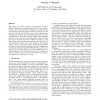Free Online Productivity Tools
i2Speak
i2Symbol
i2OCR
iTex2Img
iWeb2Print
iWeb2Shot
i2Type
iPdf2Split
iPdf2Merge
i2Bopomofo
i2Arabic
i2Style
i2Image
i2PDF
iLatex2Rtf
Sci2ools
SIGCOMM
1996
ACM
1996
ACM
A Channel Access Scheme for Large Dense Packet Radio Networks
Prior work in the
eld of packet radio networks has often assumed a simple success-if-exclusive model of successful reception. This simple model is insucient to model interference in large dense packet radio networks accurately. In this paper we present a model that more closely approximates communication theory and the underlying physics of radio communication. Using this model we present a decentralized channel access scheme for scalable packet radio networks that is free of packet loss due to collisions and that at each hop requires no per-packet transmissions other than the single transmission used to convey the packet to the next-hop station. We also show that with a modest fraction of the radio spectrum, pessimistic assumptions about propagation resulting in maximum-possible self-interference, and an optimistic view of future signal processing capabilities that a self-organizing packet radio network may scale to millions of stations within a metro area with raw per-station rates...
Related Content
| Added | 08 Aug 2010 |
| Updated | 08 Aug 2010 |
| Type | Conference |
| Year | 1996 |
| Where | SIGCOMM |
| Authors | Timothy J. Shepard |
Comments (0)

